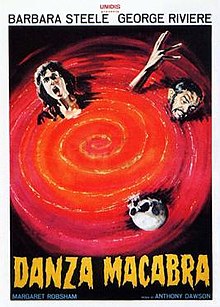In recent weeks I've been gorging on Italian Gothic Horror films of the 'classic' era: 1957 to the late 1960s. Many of them can be found online, although where possible I've tried to view them on DVD or Blu-ray. One of the few I haven't managed to track down in its full English version is An Angel for Satan Un Angelo per Satana - any help appreciated.
As my guide I've been using Jonathan Rigby's Eurogothic and the definitive book on the subject: Italian Gothic Horror Films 1957-1969 by Roberto Curti (quite pricey to acquire it has to be said).
My preference is for horror films with atmosphere rather than buckets of gore, although many of these Italian Gothics are more explicit and violent than British films from that time - some versions have brief nude scenes for example. The Ghost (Lo Spettro) includes a grisly razor attack -from Barbara Steele of course - seen from the victim's point of view with the screen gradually reddening, which is very gross for the period. One of the most important early Italian Gothics The Horrible Dr Hichcock has a central character who is a necrophile. The Ghost is a kind of sequel to this film and both are directed by Riccardo Freda, who adopted the alias Robert Hampton as it was thought at that point that British names on the credits made a horror film perform better at the box office.
After viewing a few it becomes difficult to differentiate one film from another: the eldritch castle, billowing curtains, secret passages and the same actors - especially Barbara Steele whose fame rests on her work in this genre - she's still alive at time of writing. If I ever see another hand reach from offscreen to touch an unsuspecting character on the shoulder I'll scream louder than one of the terrified Gothic heroines. I do love the production design of many of these films, again something that Bava excels in, but there are a number of other impressive examples.
The chief influences are clear - it's interesting, as with most movies, that they rely more on previous films than the literary works on which they are often based - Edgar Allan Poe is frequently referenced, but few of these films faithfully recreate any of his stories (he even puts in a personal appearance in the excellent Castle of Blood/ La Danza Macabra 1964). Roger Corman was making a good job of transferring Poe to the big screen and The Pit and the Pendulum was admitted by many of the Italian directors to be a big influence. Other obvious sources are: Hammer's 1959 Dracula, Franju's Eyes Without a Face, Clouzot's Les Diaboliques and Hitchcock's Rebecca. Vampires are popular, but one recurrent theme is the search for eternal youth or eternal life achieved through blood transfusions, a trope that also occurs in one of my personal favourites The Mill of the Stone Women which substitutes a creepy windmill for the ubiquitous cobwebbed castle and unusually is set in Holland.
Apart from the obvious candidates such as Mario Bava's Black Sunday and Kill Baby Kill (mentioned in a previous blog post) some other favourites were: Nightmare Castle (Mario Caiano 1965), The Whip and the Body La Frusta e il Corpo (directed by Mario Bava, with Christopher Lee administering the flagellation, very explicit for the period) and The Witch/ La Strega in Amore (see here also), a very stylish and absorbing film that's almost Pinteresque in its characterisation.
My least favourite was The Bloody Pit of Horror (1965) which I thought was terrible - it does however have its fans, see here. The director Domenico Massimo Pupillo's two other forays into the genre are much better: Terror Creatures From the Grave and La Vendetta di Lady Morgan.
Another film I enjoyed recently - a kind of English version of an Italian Gothic is The Black Torment (1964) which I thought was an atmospheric piece that captured the historic period in which it's set. The director Robert Hartford-Davis went on to direct the even more manic Corruption which I reviewed in an earlier post and 1965's Gonks Go Beat (!)

















No comments:
Post a Comment